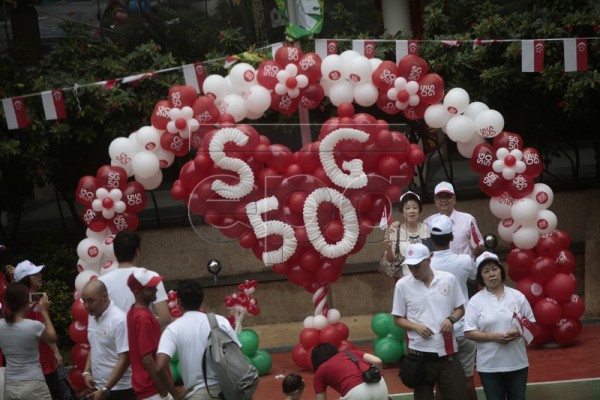
Singapore threw a big party Sunday for the 50th anniversary of independence and unrivaled economic success in a region struggling with poverty and political instability, even as the city-state began feeling the pinch of a midlife crisis.
As fighter jets screamed through the sky, nationalist songs blaring, leaders made speeches and people took advantage of free rides on trains and buses. While marveling at the island’s leap from a poor colonial port to a wealthy metropolis, Singaporeans are also grappling with a growing resentment over political restrictions, an influx of foreign labor and rising cost of living.
“This is a milestone. Coming from an older generation that has seen Singapore through the early years of independence, I know it took hard work by our leaders to get here,” said William Nathan, 70.
The weekend of celebrations culminates with fireworks after a military parade on Sunday. The sense of unity and pride in Singapore’s achievements was reinforced with a tribute video dedicated to its founder and longest serving leader, Lee Kuan Yew, who died in March at age 91, after running a virtually one-party state.
To Lee and his cohort of leaders, setting Singapore on the path of economic success meant putting in place tough policies to try to harmonize a racial mix of majority Chinese and minority Malays and Indians.
Lee, who was prime minister for more than three decades, had no tolerance for political dissent. Opposition figures were either defeated in elections or taken to court on charges of defamation until they were bankrupt. The country’s laws prohibit bankrupts from contesting elections.
His son, Prime Minister Lee Hsien Loong, is now steering Singapore with similar restrictions, and is facing a general election expected to be held Sept. 12. The ruling People’s Action Party, which holds 80 out 87 Parliament seats, suffered its worst results in 2011 elections.
Most of the mainstream media are controlled by government-linked companies, and few independent news websites are wary of strict defamation laws that government leaders have often used to silence critics.
The Reporters Without Borders’ 2015 World Press Freedom Index ranked Singapore 153rd of 180 countries, below Gambia and the Democratic Republic of Congo.
The government’s recent moves to take a teenage blogger to court and require popular news sites to obtain licenses were met with outrage from the online community. But there were no street protests — demonstrations in Singapore can only be held in a designated area, the 0.97-hectare (2.4-acre) Hong Lim Park. All other gatherings require police permit.
“Robbing Singaporeans of freedom is like killing part of the nation’s soul at any time. Is there a price on stealing a soul?” said senior research associate Bridget Welsh of the National Taiwan University’s Center for East Asia Democratic Studies.
“Singaporeans would have made more progress if there had been more freedom, more ideas, more voices to address the country’s challenges,” she said.
When the population boomed to over 2 million in the 1970s from 1.89 million at independence, Lee vigorously campaigned for women to stop at two children – fearing it would impede economic growth. He also carved a place for a second language in the English-medium education system to make Singaporeans more marketable.
But as Singaporeans grew more educated and wealthy, wages rose, and the ruling party looked to the rest of Southeast Asia for blue-collared manpower to keep the wheels turning.
Today, Singapore is among the top five most expensive cities in the world.
An unpopular government policy paper in 2013 predicted that foreigners will make up nearly half of the population of 6.5-6.9 million by 2030 to offset low birth rates and support an aging population. It triggered a rare protest of more than 2,000 against foreign labor.
“We want the government to know that we are not happy, and you can’t push everything down our throats. Peaceful protests are a legal platform for Singaporeans to voice out,” said organizer Gilbert Goh, who has since held several smaller rallies.
NY TIMES

Leave a Reply
You must be logged in to post a comment.